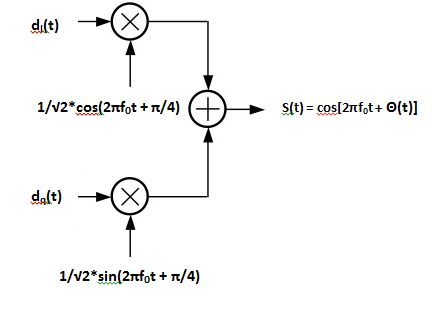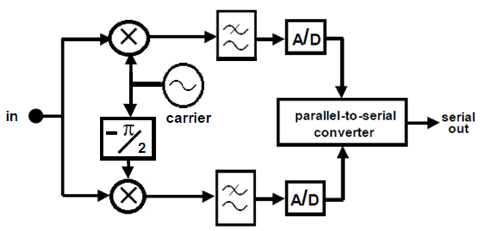This technique is also known as quaternary PSK, quadriphase PSK or 4-PSK. QPSK refers to a type of phase modulation technique where there are four states involved. It uses four points on the constellation diagram, equispaced around a circle. Since QPSK has four phases, it can encode two bits per symbol, thereby increasing the data rate.
In QPSK the original data stream dk(t) = d0 , d1 , d2 ,… is divided into an in-phase stream, dI(t), and a quadrature stream, dq(t).
dI(t) = d0 , d2 , d4, …
dq(t) = d1, d3, d5, …
dI(t) and dq(t) each have half the bit rate of dk(t). A convenient orthogonal realization of a QPSK waveform, S(t), is achieved by amplitude modulating the in-phase and quadrature data streams onto the cosine and sine functions of a carrier wave as follows.
S(t) = 1/√2 * dI(t) cos(2πf0t + π/4) + 1/√2 * dq(t) sin(2πf0t + π/4) :(1)
Using trigonometric identities, this equation can also be written as
S(t) = cos[ 2πf0t + Θ(t) ]
The value of Θ(t) will correspond to one of the four possible combinations of dI(t) and dq(t) in the equation (1).
Θ(t) = 0o , ± 90o , or 180o.
QPSK MODULATOR
QPSK DEMODULATOR
A slight modification to this basic QPSK technique gives various other forms of modulation techniques such as DQPSK, OQPSK, π/4 QPSK etc. These techniques are more efficient in different scenarios when compared to basic QPSK. One technique that interests us is that of DQPSK.
Differential phase shift keying (DPSK) conveys data by changing the phase of the carrier wave. In the QPSK method there is an ambiguity of phase if the constellation is rotated by some effect in the communications channel through which the signal passes. This problem can be solved by using a technique such that each data is represented with a particular phase and having this phase information transmitted over the carrier. The receiver then takes the difference of two adjacent phase decisions to arrive at the decision on the information phase - thereby using this information to demodulate. Hence DQPSK (Differential Quadrature Phase Shift Keying) is more resistant to frequency/phase rotation errors in the carrier reception.
As DQPSK is more resistant to frequency/phase rotation errors and considering that our signals have to travel a long distance through space we prefer this modulation technique for our data transmission.



